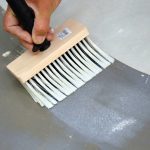Bathroom of the wettest rooms in the house, apartment. According to current building codes, its floor, walls must be protected by waterproofing, which prevents water from entering the structures, under the cladding, protects them from premature destruction.

It is especially important to create a waterproof “trough” on the bathroom floor that will not let water through the floor. In this case, not only the floor is covered with waterproofing, but also the lower part of the walls to a height of 20 cm.

Our distant ancestors knew about the need for waterproofing, especially in bathrooms. In those days there were no modern waterproofing materials, so it was arranged by coating the surface with mineral oils, animal fat. After the invention of concrete, it began to be widely used.

Today, waterproofing from the marked materials is not done, as it is considered unreliable, performs its functions for a short time. Partially used concrete, cement mortar, but modified by the addition of water glass, special polymers. The latter increase the resistance of concrete, mortar against water penetration, which will explain their use as waterproofing layers in buildings under construction or under repair today.

Currently, it is characterized by the presence on the market of a large number of different materials produced for waterproofing devices. Which one to apply depends on many factors, including:
- In what condition is the surface that needs to be closed with waterproofing;
- How many floors in the house, structure; what materials interfloor overlays are made of;
- What are the deadlines for the performance of work;
- Is it possible to reduce the height of the room.

There are mainly five modern methods of waterproofing. The simplest, most demanded is coating. The material used in it is bitumen mastic. It is liquid, therefore it is easily applied to the surface with a brush, roller. After a certain time, it hardens, forming an airtight layer on the floor and walls through which water cannot penetrate.

In addition to the described, there is a gluing waterproofing. It is made by flexible membranes, one of the sides of which is covered with bitumen. These are known only roofing materials, but it is better to use modern materials, for example, TechnoNICOL. In the latter, instead of bitumen, a layer of glue is applied, by which the material quickly adheres to surfaces.

A good option is cast waterproofing. It is made of special polymer mastics, which are applied to the surface with a brush, spatula. As a result, after hardening, the material forms a water-impermeable layer.

There is a method of waterproofing using a backfill arranged from hydrophobic materials. It is used in combination with others, arranging over, for example, cast waterproofing.

-
 How much concrete will be obtained from one bag of cement
How much concrete will be obtained from one bag of cement
-
 Why bad frame houses
Why bad frame houses
-
 What mistakes do beginners make when working with foam
What mistakes do beginners make when working with foam
-
 How to make a primer from bitumen mastic
How to make a primer from bitumen mastic
-
 How to get electricity from the earth
How to get electricity from the earth
-
 Interesting facts about self-tapping screws
Interesting facts about self-tapping screws
-
 Is it efficient to get electricity from solar panels?
Is it efficient to get electricity from solar panels?
-
 Why you should not postpone the repayment of debts for electricity
Why you should not postpone the repayment of debts for electricity
-
 Reasons for the popularity of ceramic tiles
Reasons for the popularity of ceramic tiles
-
 Mistakes that lead to fast sagging doors
Mistakes that lead to fast sagging doors
-
 What primers are not suitable for application under fiberboard
What primers are not suitable for application under fiberboard
-
 Features of rattan furniture
Features of rattan furniture
New publications are published daily on our channel in Yandex. Zen
Go to Yandex. Zen


